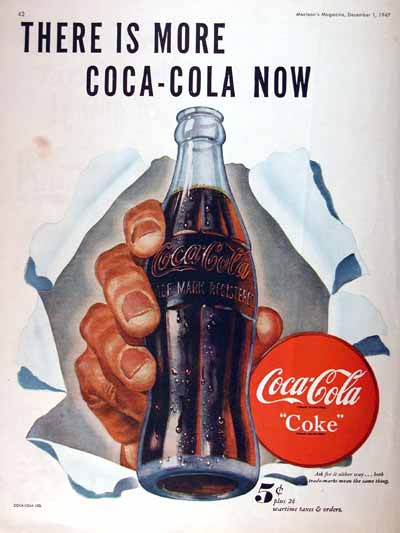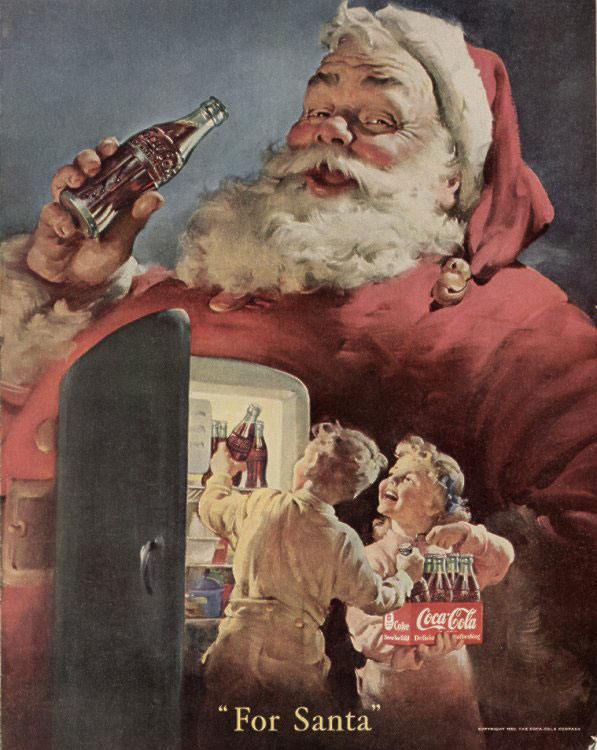This newspaper ad from 1951 years is really weird, someone was selling ice cold Coca-Cola for 7 cents and getting 2 cents more than the rest of the country.

Newspaper ad from 1951, Coca-Cola for 7 cents
Maybe this somehow related to these ads from 1947 and 1949, where was 2 cents wartime tax included or maybe not…

1947 Coca Cola advertisement. Illustrated in vibrant color. Includes 2¢ wartime tax special pricing.

1949 Coca Cola advertisement. Illustrated in vivid color at the seaside with an ice cooler below. Price still included the 2¢ wartime tax.

Coca-Cola: for Santa 1950

The Coca-Cola Santa Claus artwork from 1951 shows Santa reading a list of good boys and girls; there is no list of bad children.

Coca-Cola for sparkling holidays 1953
Although many credit our modern day Santa to Thomas Nast, Santa’s jolly look all started in 1931 with Haddon Sundblom and Coca-Cola.
Legendary illustrator Haddon Sundblom created the rosy-cheeked figure – today’s traditionally accepted appearance of the jolly old elf – in 1931 for a Coke holiday advertising campaign. Since that time, the Coca-Cola Santa has become one of the most beloved cultural icons and an anticipated part of holiday tradition.

My hat's off to the pause that refreshes 1931

It will refresh you too 1932

Away with a tired thirsty face 1933

Coca-Cola advertising clock Circa 1893
Coca-Cola began advertising its products on clocks in 1893, when such novelty advertisements were increasingly common.
Coke would distribute branded clocks to sellers who bought and sold at least 100 gallons of Coca-Cola syrup per year. The first Coca-Cola clocks were made by the Baird Clock Company of Plattsburgh, New York, and had big, round faces with Roman numerals.
At $2.75 each, clocks were relatively expensive to produce, but Coca-Cola made the investment knowing that, because of their usefulness, advertising clocks would stay on display in a store long after posters or other items had been discarded.

1932 Coca-Cola Uncle Remus Cutout That Sparked Copyright Lawsuit
In 1932, the Coca-Cola Company issued a children’s cutout based on the Uncle Remus stories. The Company had negotiated rights with the publisher, Appleton, to use the Arthur Frost illustrations on the advertising. Mrs. Harris sued for copyright infringement. Ultimately, the courts ruled in favor of the Company. While Mrs. Harris had the rights to the stories, the illustrations belonged to the publisher.

Drink a bottle of Coca-Cola and be lucky
Coca-Cola used the swastika again in 1925 when it introduced a watch fob in that design. The swastika was widely used as a symbol of good luck or good fortune prior to the Second World War.
Why have a dull soda season? Coca-Cola, like tea and coffee, is a year around drink. Hold your summer trade by serving Coca-Cola both hot and cold through the winter season.

Hot Coca-Cola spiced ad 1907
In 1943, Coca-Cola put out an advertisement urging people to buy U. S. War Bonds and War Stamps.Coca-Cola strongly aligned itself with the war effort. The newly created elf-looking Coca-Cola mascot named “Sprite” appears in the new advertisements.

Coca-Cola War Bonds - For Victory

Buy more War Bonds = A quicker Victory
In 1925 Coca Cola made a lucky watch fob in the shape of a swastika with the slogan, “Drink Coca Cola five cents in bottles.” At that time, the Swastika was still a symbol of ‘Good Luck’. The watch fob is approximately 4cm x 4cm in size and is made of brass.

Coca Cola swastika

















